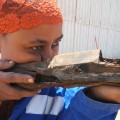How a diamond rush led to an ancient, underwater secret

They mined for diamonds, found something even more rare 08:19
(CNN)In
1908, a German prospector found a diamond in the Namibian Desert. The
area came to be known as the Sperrgebiet, or "forbidden territory," and
was soon overrun by Germans on the hunt for the precious stone (they
annexed 10,000 square miles of the desert for themselves). Today,
DeBeers and the Namibian government still run a joint operation in the
area.





 But
on April 1, 2008 a worker discovered something far more valuable. He'd
been searching for diamonds but struck on gold -- only this gold had
been missing for nearly half a millennia.
But
on April 1, 2008 a worker discovered something far more valuable. He'd
been searching for diamonds but struck on gold -- only this gold had
been missing for nearly half a millennia. The smoking gun
What
was found that day had not been seen since the fifteenth century. The
miners themselves did not know what they had hit on when they discovered
pieces of metal, wood and pipes while they were bulldozing. At a loss,
they called in an archaeologist.
Dieter Noli remembers first surveying the scene:
"It
just looked like a disturbed beach, but lying on it were bits and
pieces," he recalls. He uncovered a 500-year-old musket and elephant
tusks.
"I thought 'Oh, no no, this is definitely a shipwreck.'"
After scrutinizing the find, archaeologists now think it might be one of the most significant shipwrecks ever found.
Though
they are unable to unequivocally prove it, overwhelming evidence
suggests the vessel is The Bom Jesus ("The Good Jesus"), a Portuguese
ship on its way to India that never made its way beyond the Southern
Atlantic.
Loaded with thousands of
mint condition, pure gold coins from Spain and Portugal, historians are
able to date the ship to between 1525 and 1538, whilst the cargo matches
that on The Bom Jesus, as detailed in a rare sixteenth century book
"Memorias Das Armadas", which lists the vessel as lost.
How the ship was lost
From evidence at the site, Noli and his team have pieced together what happened to The Bom Jesus.
(click to see video "Namibia's ancient shipwreck")
"We figured out the ship came in, it hit a rock and it leaned over," he
says. "The superstructure started breaking up and the chest with the
coins was in the captain's cabin, and it broke free and fell to the
bottom of the sea intact... In breaking up, a very heavy part of the
side of the ship fell on that chest and bent some of the coins. You can
see the force by which the chest was hit, but it also protected the
chest."
Among the haul of gold, tin and ivory
were 44,000 pounds of copper ingots, which according to marine
archaeologist Bruno Werz could be key to the ship's preservation.
"Wooden
remains would normally have been eaten by organisms," he explains, "but
the poison would have protected part of those materials."
The
diamond mine's security now protects the remains of the shipwreck.
Timber, muskets, cannonballs and swords are kept damp, as they have been
since the sixteenth century. In-keeping with the secretive area in
which it was discovered, most of the find remains out of the public eye,
like the Sperrgebiet itself.
There
are hopes however that this will soon change, and a museum featuring
the shipwreck is currently being mooted. After 500 years locked away in
the sand, one hopes The Bom Jesus will enjoy the attention.







No comments: